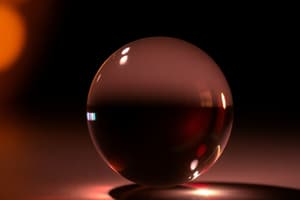Podcast
Questions and Answers
What phenomenon describes the emission of electrons when light is shined on a material?
What phenomenon describes the emission of electrons when light is shined on a material?
- Photoelectric effect (correct)
- Scattering
- Reflection
- Diffraction
Which property indicates that light does not require a medium for propagation?
Which property indicates that light does not require a medium for propagation?
- Speed of light
- Polarization
- Transverse nature
- Electromagnetic wave propagation (correct)
Which of the following wavelengths is the human eye most sensitive to?
Which of the following wavelengths is the human eye most sensitive to?
- 550 nm (correct)
- 600 nm
- 350 nm
- 700 nm
How does the speed of light change when it moves from one medium to another?
How does the speed of light change when it moves from one medium to another?
What occurs to the amplitude of light when it passes from one medium to another?
What occurs to the amplitude of light when it passes from one medium to another?
What type of light consists of a single wavelength?
What type of light consists of a single wavelength?
Which of the following statements about the eye's sensitivity to different wavelengths is true?
Which of the following statements about the eye's sensitivity to different wavelengths is true?
What happens to the frequency of light when it travels from air into water?
What happens to the frequency of light when it travels from air into water?
Study Notes
Phenomena of Light
- Light undergoes four primary phenomena: photoelectric effect, scattering, emission, and absorption.
Properties of Light
- Light is an electromagnetic wave, allowing it to propagate without a medium.
- In a vacuum, light travels at a speed of 3 x 10^8 m/s (or 186,000 miles/s).
- Light is transverse and can be polarized.
- It is unaffected by electric and magnetic fields.
- Light's velocity and wavelength change when transitioning between media; however, frequency and color remain constant. Example: Red light's speed and wavelength differ in water compared to air, but its frequency and color do not change.
- All wavelengths of light travel at the same speed (3 x 10^8 m/s) in a vacuum, but in different media, their speeds vary.
- The speed of light decreases in denser media; thus, light travels slower in denser materials.
Visible Light and the Eye
- The human eye is sensitive to visible light within the wavelength range of 390 to 600 nm.
- Cornea absorbs light rays shorter than 295 nm, allowing wavelengths between 295 and 600 nm to reach the crystalline lens.
- Normal human eyes do not perceive ultraviolet rays (350 to 400 nm) as these are absorbed by the crystalline lens.
- Aphakic eyes can detect wavelengths between 350 and 400 nm, leading to a perception of bluer visuals compared to pre-operation.
- The eye is most sensitive to yellow-green light at a wavelength of 550 nm, with sensitivity declining for violet and red light.
Sensitivity of Eye to Visible Spectrum of Light
- The sensitivity curve of the human eye shows varying response across different wavelengths, with peaks at yellow-green (550 nm) and significantly lower sensitivity at the extremes of violet and red.
Conclusion
- Monochromatic light consists of a single wavelength, while white light is composed of multiple wavelengths (heterochromatic).
- Light demonstrates various behaviors such as reflection, refraction, absorption, diffraction, interference, and polarization, which will be explored further in future study.
Studying That Suits You
Use AI to generate personalized quizzes and flashcards to suit your learning preferences.
Description
Test your knowledge on the phenomena and properties of light. This quiz covers topics like the photoelectric effect, scattering, emission, and absorption of light. Dive into the fascinating world of optics and discover the fundamental principles that govern light's behavior.




